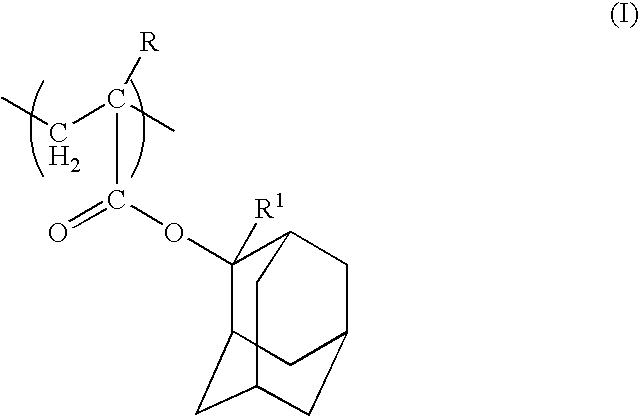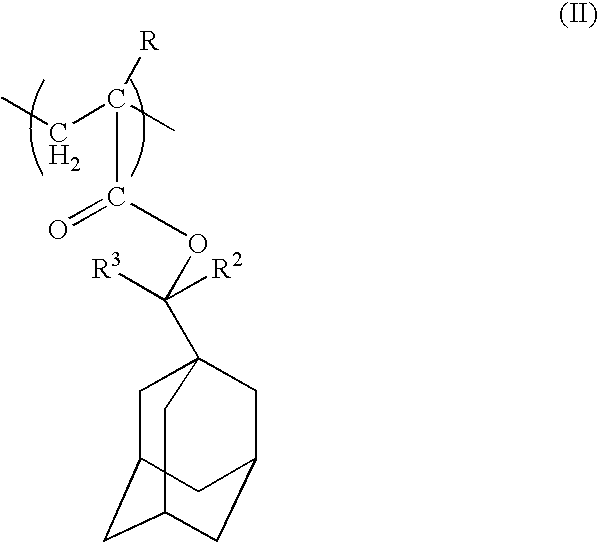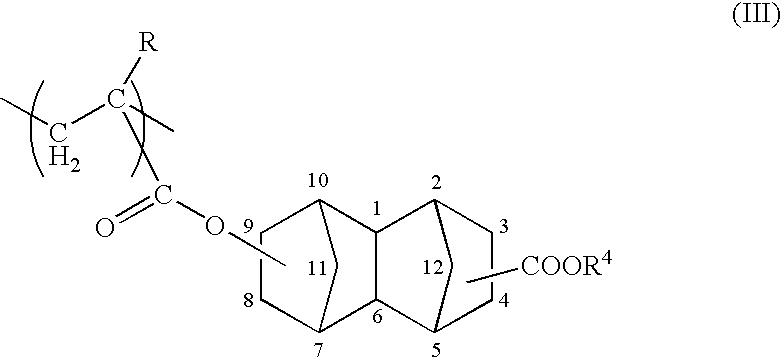Resist composition, multilayer body, and method for forming resist pattern
- Summary
- Abstract
- Description
- Claims
- Application Information
AI Technical Summary
Benefits of technology
Problems solved by technology
Method used
Image
Examples
example 1
[0186] 0.25 mols of a 30 / 50 / 20 (molar ratio) mixture of 2-ethyl-2-adamantyl acrylate, norbomane lactone acrylate of the general formula (i) (wherein R is a hydrogen atom), and 3-hydroxy-1-adamantyl acrylate of the general formula (VI) (wherein R is a hydrogen atom) was dissolved in 500 ml of methyl ethyl ketone (MEK), and 0.01 mols of AIBN was then added to the solution and dissolved. The thus obtained solution was heated to a temperature of 65 to 70° C., and maintained at this temperature for 3 hours. Subsequently, the reaction solution was poured into 3 L of vigorously stirred isopropanol, and the precipitated solid was isolated by filtration. The thus obtained solid product was dissolved in 300 ml of MEK, poured into 3 L of vigorously stirred methanol, and once again the precipitated solid was isolated by filtration and then dried, yielding a resin X for which the weight average molecular weight (Mw)=10,000, Mw / Mn=2.0, and Tg =approximately 130° C. 0.25 mols of a 40 / 40 / 20 (molar ...
example 2
[0196] With the exception of replacing the component (A) of the example 1 with a single copolymer (a resin Z, for which weight average molecular weight (Mw)=10,000, Mw / Mn=1.9, and Tg=approximately 160° C.), which was produced from a 40 / 40 / 20 (molar ratio) mixture of 2-ethyl-2-adamantyl methacrylate, norbomane lactone acrylate of the general formula (i) (wherein R is a hydrogen atom), and 3-hydroxy-1-adamantyl acrylate of the general formula (VI) (wherein R is a hydrogen atom) using the same method as the example 1, a positive resist composition was prepared in the same manner as the example 1.
[0197] Subsequently, with the exception of altering the PEB temperature to 90° C., a resist pattern was formed in the same manner as the example 1, thereby yielding a hole pattern with a hole diameter of 140 nm.
[0198] Finally, when a shrink process using a water-soluble coating was conducted in the same manner as the example 1, the size of the hole pattern was reduced by approximately 20 nm, ...
PUM
| Property | Measurement | Unit |
|---|---|---|
| Temperature | aaaaa | aaaaa |
| Solubility (mass) | aaaaa | aaaaa |
Abstract
Description
Claims
Application Information
 Login to View More
Login to View More - R&D
- Intellectual Property
- Life Sciences
- Materials
- Tech Scout
- Unparalleled Data Quality
- Higher Quality Content
- 60% Fewer Hallucinations
Browse by: Latest US Patents, China's latest patents, Technical Efficacy Thesaurus, Application Domain, Technology Topic, Popular Technical Reports.
© 2025 PatSnap. All rights reserved.Legal|Privacy policy|Modern Slavery Act Transparency Statement|Sitemap|About US| Contact US: help@patsnap.com



